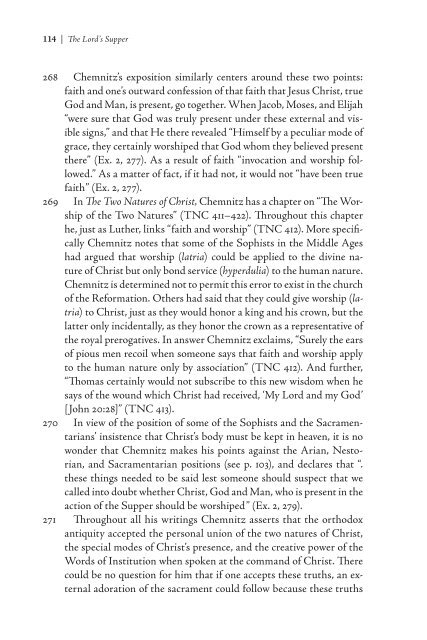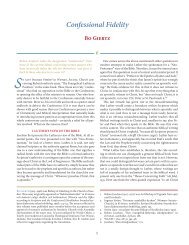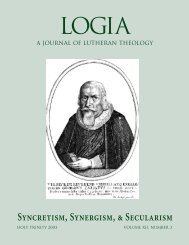The Lord's Supper in the Theology of Martin Chemnitz Bjarne - Logia
The Lord's Supper in the Theology of Martin Chemnitz Bjarne - Logia
The Lord's Supper in the Theology of Martin Chemnitz Bjarne - Logia
Create successful ePaper yourself
Turn your PDF publications into a flip-book with our unique Google optimized e-Paper software.
| <strong>The</strong> Lord’s <strong>Supper</strong><br />
268 <strong>Chemnitz</strong>’s exposition similarly centers around <strong>the</strong>se two po<strong>in</strong>ts:<br />
faith and one’s outward confession <strong>of</strong> that faith that Jesus Christ, true<br />
God and Man, is present, go toge<strong>the</strong>r. When Jacob, Moses, and Elijah<br />
“were sure that God was truly present under <strong>the</strong>se external and visible<br />
signs,” and that He <strong>the</strong>re revealed “Himself by a peculiar mode <strong>of</strong><br />
grace, <strong>the</strong>y certa<strong>in</strong>ly worshiped that God whom <strong>the</strong>y believed present<br />
<strong>the</strong>re” (Ex. 2, 277). As a result <strong>of</strong> faith “<strong>in</strong>vocation and worship followed.”<br />
As a matter <strong>of</strong> fact, if it had not, it would not “have been true<br />
faith” (Ex. 2, 277).<br />
269 In <strong>The</strong> Two Natures <strong>of</strong> Christ, <strong>Chemnitz</strong> has a chapter on “<strong>The</strong> Worship<br />
<strong>of</strong> <strong>the</strong> Two Natures” (TNC 411–422). Throughout this chapter<br />
he, just as Lu<strong>the</strong>r, l<strong>in</strong>ks “faith and worship” (TNC 412). More specifically<br />
<strong>Chemnitz</strong> notes that some <strong>of</strong> <strong>the</strong> Sophists <strong>in</strong> <strong>the</strong> Middle Ages<br />
had argued that worship (latria) could be applied to <strong>the</strong> div<strong>in</strong>e nature<br />
<strong>of</strong> Christ but only bond service (hyperdulia) to <strong>the</strong> human nature.<br />
<strong>Chemnitz</strong> is determ<strong>in</strong>ed not to permit this error to exist <strong>in</strong> <strong>the</strong> church<br />
<strong>of</strong> <strong>the</strong> Reformation. O<strong>the</strong>rs had said that <strong>the</strong>y could give worship (latria)<br />
to Christ, just as <strong>the</strong>y would honor a k<strong>in</strong>g and his crown, but <strong>the</strong><br />
latter only <strong>in</strong>cidentally, as <strong>the</strong>y honor <strong>the</strong> crown as a representative <strong>of</strong><br />
<strong>the</strong> royal prerogatives. In answer <strong>Chemnitz</strong> exclaims, “Surely <strong>the</strong> ears<br />
<strong>of</strong> pious men recoil when someone says that faith and worship apply<br />
to <strong>the</strong> human nature only by association” (TNC 412). And fur<strong>the</strong>r,<br />
“Thomas certa<strong>in</strong>ly would not subscribe to this new wisdom when he<br />
says <strong>of</strong> <strong>the</strong> wound which Christ had received, ‘My Lord and my God’<br />
[John 20:28]” (TNC 413).<br />
270 In view <strong>of</strong> <strong>the</strong> position <strong>of</strong> some <strong>of</strong> <strong>the</strong> Sophists and <strong>the</strong> Sacramentarians’<br />
<strong>in</strong>sistence that Christ’s body must be kept <strong>in</strong> heaven, it is no<br />
wonder that <strong>Chemnitz</strong> makes his po<strong>in</strong>ts aga<strong>in</strong>st <strong>the</strong> Arian, Nestorian,<br />
and Sacramentarian positions (see p. 103), and declares that “.<br />
<strong>the</strong>se th<strong>in</strong>gs needed to be said lest someone should suspect that we<br />
called <strong>in</strong>to doubt whe<strong>the</strong>r Christ, God and Man, who is present <strong>in</strong> <strong>the</strong><br />
action <strong>of</strong> <strong>the</strong> <strong>Supper</strong> should be worshiped” (Ex. 2, 279).<br />
271 Throughout all his writ<strong>in</strong>gs <strong>Chemnitz</strong> asserts that <strong>the</strong> orthodox<br />
antiquity accepted <strong>the</strong> personal union <strong>of</strong> <strong>the</strong> two natures <strong>of</strong> Christ,<br />
<strong>the</strong> special modes <strong>of</strong> Christ’s presence, and <strong>the</strong> creative power <strong>of</strong> <strong>the</strong><br />
Words <strong>of</strong> Institution when spoken at <strong>the</strong> command <strong>of</strong> Christ. <strong>The</strong>re<br />
could be no question for him that if one accepts <strong>the</strong>se truths, an external<br />
adoration <strong>of</strong> <strong>the</strong> sacrament could follow because <strong>the</strong>se truths




